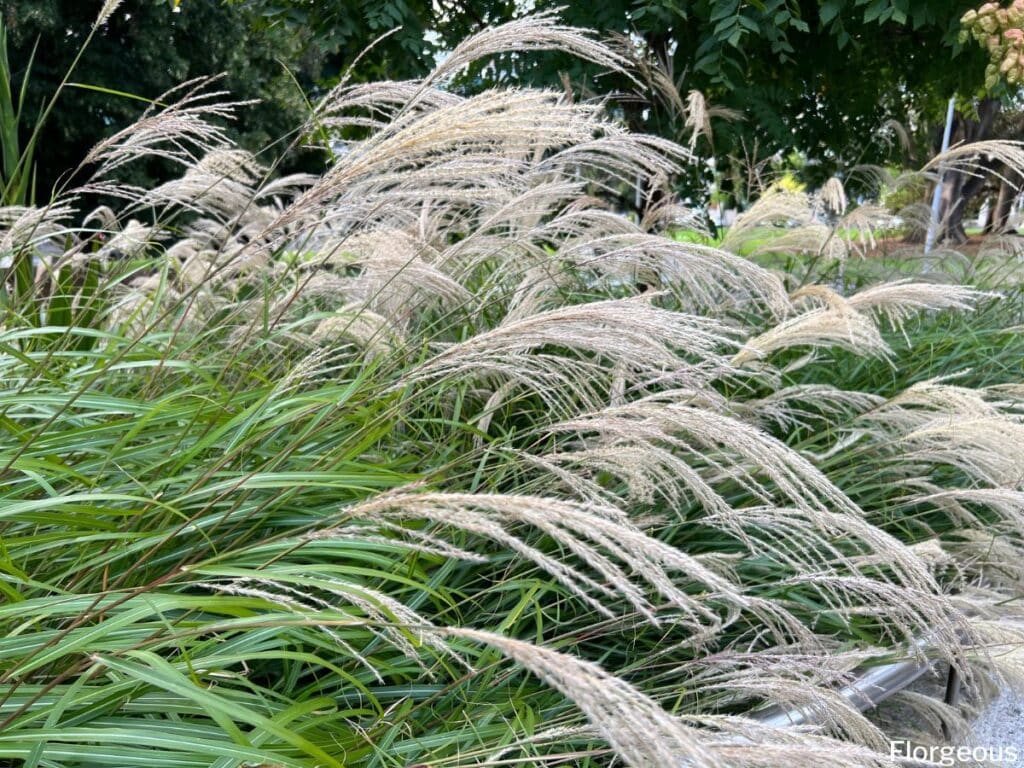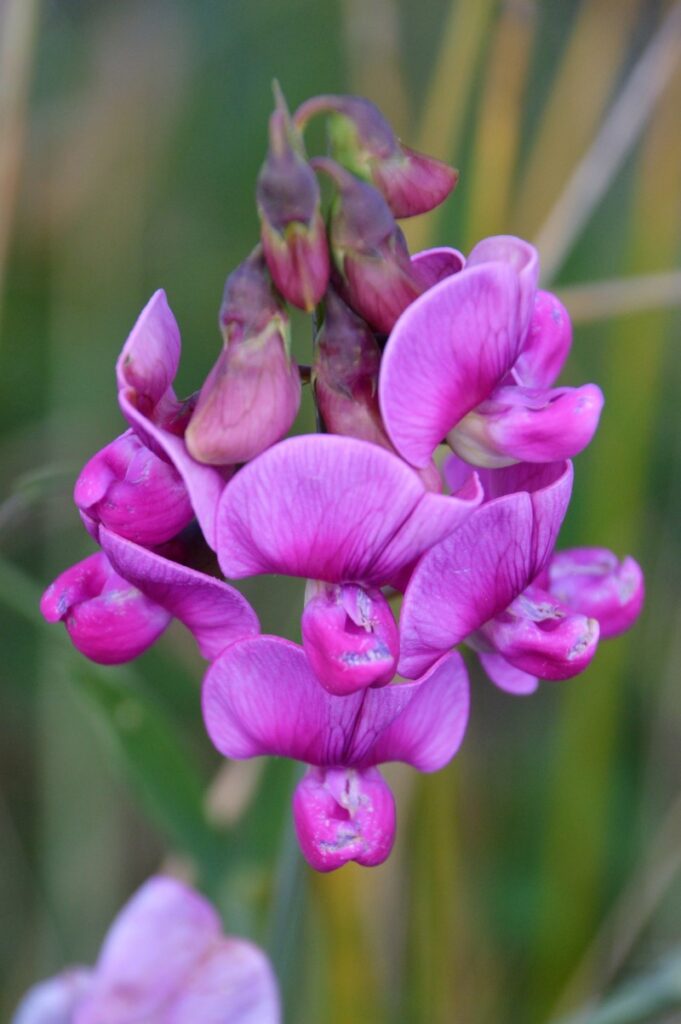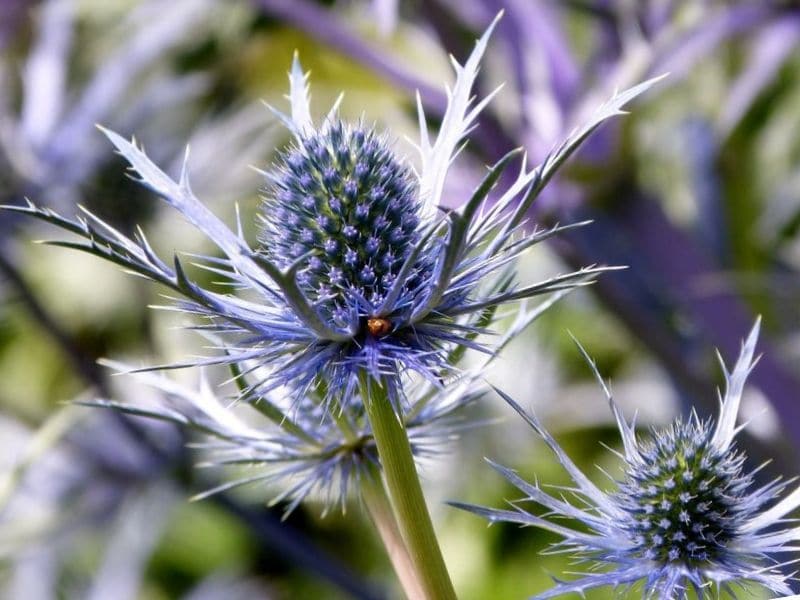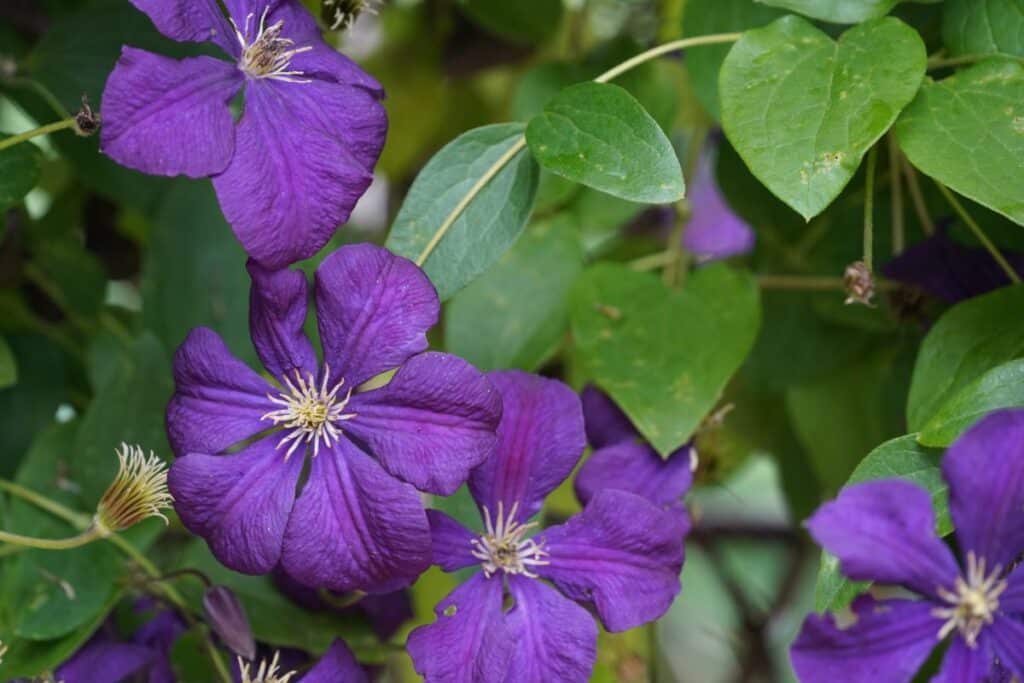Clematis (Clematis spp.), also known as Western blue virginsbower, is a member of the buttercup family and a very sweet species to have in your garden because it can be used as a plant trellis for garden walls, trees, or fences. Some gardeners also love to use this vine plant as a ground cover or living mulch for their garden beds.
These beautiful clematis flowers can be paired with companion plants such as ornamental grasses, sweet peas, carpet roses, Japanese maple trees, or sea holly flowers to create interesting garden beds.
Let’s take a closer look at these clematis companions and discuss some creative ways to use them along with other plants in your garden.
What to Grow with Clematis
Clematis is an evergreen perennial plant that will stay vibrant and green throughout the year but it will only flower during its bloom season. The bloom season for clematis can vary for different groups.
Group 1 are spring blooming varieties, group 2 will flower repeatedly if they are deadheaded, and group 3 will bloom from early summer to fall.
You can learn more about different types of clematis on our website.
When you are selecting companion plants for clematis, it is usually best to focus on plant species that have a similar growing season and similar growing requirements.
Clematis plants will only flower properly if they are positioned in an area where they will receive at least six hours of direct sun per day.
When it comes to clematis plant care, you need moist, neutral to slightly alkaline soil types that drain well.
Let’s explore some other plants that also love plenty of sunlight and moist soil with a slightly high pH level.
Ornamental Grasses

Your clematis trellis will look charming if you add a couple of showy ornamental grasses in front of it. It is best to select moisture-loving grass varieties like Morning light maiden grass (Miscanthus sinesis), also known as Chinese silver grass along with your clematis plants.
These beautiful grasses prefer full sun and can grow well in average-draining soils or well-drained soil that is watered regularly. Morning light grass can be drought tolerant but it won’t be affected by the high moisture levels that clematis requires.
When you grow clematis vines behind this showy grass variety, it will create a striking contrast, especially if you select clematis with bright flower colors like purple clematis.
Flowering Sweet Peas

Sweet peas (Lathyrus odoratus), also known as the perennial pea or everlasting pea, can look charming with clematis because they produce showy vibrant flowers and it is also a climbing plant that can reach a height of up to 2 meters tall.
These ornamental plants do produce seed pods that look very similar to the seed pods of perennial crops like peas but these seeds are poisonous and shouldn’t be consumed.
The flowers will grow very well if they have plenty of direct sunlight and they prefer cool and moist soil.
The best way to combine them is by positioning these clematis companion plants in the back with clematis growing around the base of the flowers so they can keep the soil moist and cool. When both plants produce flowers, they will create showy displays of color.
Groundcover Roses
Groundcover roses (Rosa KORresia), also known as carpet roses, are great plants to grow in front of trellised clematis or at base of clematis vines because these roses will keep the soil cool and can promote the growth of your vines.
If you want your carpet roses to produce excessive blooms then you should place them in a sunny spot in well-draining soil.
Ground-cover roses have a similar bloom time as clematis and will also flower from spring to late autumn.
Japanese Maples
You can also plant different clematis varieties underneath trees and leave them to trail into the tree for an interesting effect.
Pairing clematis with Japanese maple trees (Acer palmatum) can help you create multi seasonal interest in your garden because the trees will add lots of color during the autumn season when the clematis vines stopped producing flowers.
Maple trees are good companion plants for clematis because they grow well in free-draining soil that is kept moist and they will create shade that can help your clematis flowers survive in warmer regions.
Sea Hollies

Sea holly eryngium (Eryngium) can help you enjoy clematis even more because they will add lots of texture and color to your garden with their deep blue colors and interesting leaf patterns.
These showy flowers prefer full sun positions and dry soil types but they will survive in soils that are regularly watered as long as the soil drains well and has lots of organic materials.
These flowers will only grow up to 36 inches tall and should be planted in front of your clematis trellis where they can receive a bit more sunlight.
What NOT to grow with Clematis
Clematis flowers can be paired with a great variety of plant species but gardeners should be aware that they can grow rather excessively.
In some regions, they are considered invasive and they can take over your garden and smother other species if you pair them with slow-growing plants like succulents.
The flowers also need a bit of direct sun. If you grow them directly underneath large trees, they can struggle.
These flowers need lots of moisture which means they also cannot be paired with drought-loving plants like lavender because the root system of these species can start to rot in the moist soil.
Landscaping ideas for Clematis and Companions
Now that you know more about other plants to include in your garden when planting clematis, it is time to discuss some creative ways to use them in your garden.
Here are some great landscaping ideas for clematis and its companion plants.
Create a Flowering Wall
You can trail clematis flowers over chicken wire to create a showy living wall filled with vibrant blooms.
Add other flowering plants like sea holly, groundcover roses, or ornamental grass in front of these living walls to cover the base and add some more color to your garden.
Grow Into Trees
Clematis flowers can grow well underneath trees and can look striking if you trail them up into a tree.
Trees like Japanese maples will look like they are flowering during the clematis bloom season and will still look striking when the leaves of these trees turn red or orange for fall.
Flowering Arches
Clematis vines are terrific for creating showy flowering arches. You can place these flowers in containers and grow them over a metal wire arch.
The containers can be enhanced by planting other species like groundcover roses inside them to fill out the container.
Final Thoughts
Companion plants for clematis such as Chinese silver grass, carpet roses, sweet peas, and sea holies can be wonderful species to enhance the appearance of these vine plants and you can grow clematis into trees to enhance the aesthetics of your trees or shrubs.
We hope that this guide helps you discover some good clematis companions and that our landscaping ideas will help you create a more beautiful or inspirational garden.
See more:
*image by Sujitto/depositphotos







